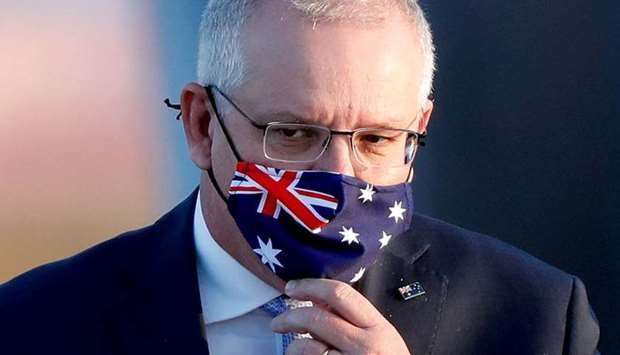Hundreds of active Covid cases in the community should not delay Australia’s plan to reopen and end widespread lockdowns, Scott Morrison said, urging people to look beyond a “one-eyed focus” on daily case numbers.
As NSW recorded 830 new cases and three deaths yesterday, the prime minister also pushed back against suggestions that case numbers were too high for Australia to move to the next phase of the plan agreed to by state leaders, saying the conclusions of the Doherty Institute modelling remained the same.
This is despite one of the architects of the Doherty modelling, Prof James McCaw, telling Guardian Australia that case numbers were too high to abandon lockdowns even if the vaccination rate reached 70%.
Morrison said this was not supported by the advice given to national cabinet by the Doherty Institute’s professor Jodie McVernon, and that once 70% of the country was vaccinated, lockdowns would be “unlikely and targeted”, regardless of how many active cases there were in the community.
“The advice we have from the Doherty Institute is the starting point does not ultimately alter the conclusions of the modelling,” Morrison told the ABC’s Insiders programme.
“As we go forward, once you get over 70% and particularly over 80%, lockdowns do more harm than good.
“Lockdowns are not a sustainable way to deal with the virus and that’s why we have to get to the 70% and 80% marks so we can start living with the virus.”
When asked if that would see the end of lockdowns, Morrison said they would be “highly unlikely and targeted” giving the example of western NSW where “strong precautions” would still be needed because of the low vaccination rate among indigenous people.
The country’s chief medical officer, professor Paul Kelly, yesterday said the Doherty Institute would present updated advice to national cabinet this week, but insisted there was no need for major changes.
“Does this need to go back to the drawing board? Absolutely not,” Kelly said.
He said the modelling always factored in the exponential growth of the virus, but the research was being updated to reflect a starting point with high rates of transmission.
“They are doing that modelling again now, but on first principles, that same effect you have at 70% and 80% would be the same effect, it would minimise the number of people in ICU particularly and in hospitalisation.”
Amid growing case numbers in NSW, Victoria and the ACT, Morrison said he thought it was “highly unlikely” that achieving zero Covid cases in the community was plausible, but insisted suppression was still needed until at least 70% of Australians were vaccinated.
“Once you do that, then you can move into focusing on the public health issues of hospitalisation and serious illness,” he said.
“Case numbers are not the whole story...but right now, of course, we need to make the lockdowns effective. We need to suppress the virus as best we can, and we need for people to isolate, stay at home, get tested and of course, go and get vaccinated.”
In an opinion piece published yesterday, Morrison said “a one-eyed focus” on case numbers “overlooks the fact that less people are getting seriously ill, let alone dying”.
The initial modelling, which underpinned the national cabinet’s plan for Australia to live with the virus, looked at what would happen with an outbreak of Covid-19 if there were 30 cases in the community, the vaccination rate was 70% and restrictions were eased.
It found that with a vaccination rate of 70%, there would be almost 400,000 cases in the community within 180 days, reducing to 230,000 cases if the vaccination rate was 80%.
It also showed that until vaccination rates reach 70% any outbreaks would likely see “rapid and uncontrolled” growth, leading to a significant number of deaths and severe cases.
Once the vaccination coverage reaches 70% and 80%, the rate of severe infections is reduced, but under an “uncontrolled outbreak” scenario, between 1,300 and 2,000 people would still die from 10,000 to 20,000 severe infections within six months.
If low-level restrictions were ongoing – such as capacity limits and social distancing – then a 70% vaccination rate would reduce deaths to as few as 16 within six months, as long as the testing, tracing, isolating and quarantine (TTIQ) regime was “optimal”.
Morrison rejected suggestions that if Australia had secured more Pfizer vaccines earlier, the country would not still be in lockdown, saying “there are many wise in hindsight”.

Scott Morrison (file picture)
